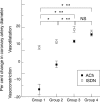Long term consequences of regressed coronary aneurysms after Kawasaki disease: vascular wall morphology and function
- PMID: 10677411
- PMCID: PMC1729327
- DOI: 10.1136/heart.83.3.307
Long term consequences of regressed coronary aneurysms after Kawasaki disease: vascular wall morphology and function
Abstract
Objectives: To investigate the long term consequences of regressed aneurysms after Kawasaki disease, using follow up coronary angiography; to assess the vascular wall morphology at the site of the aneurysms by intravascular ultrasound imaging; and to evaluate the function of the affected vessels using intracoronary infusions of acetylcholine and isosorbide dinitrate.
Design: 33 patients were studied, 27 with previous Kawasaki disease and six with congenital heart disease. All Kawasaki disease patients were followed for more than 10 years from disease onset. The 33 patients comprised four groups: group 1 included 13 Kawasaki disease patients with a total of 23 sites of regressed large sized (>/= 4 mm) coronary aneurysms; group 2 included 13 Kawasaki disease patients with 22 sites of regressed small sized (< 4 mm) coronary aneurysms (four patients had sites of both large and small sized aneurysms); group 3 included a further five Kawasaki disease patients with 25 normal coronary angiography sites in the acute stage of Kawasaki disease; and group 4 comprised the six patients with congenital heart disease as controls, with a total of 27 normal coronary angiography sites. During coronary angiography, 15 microg of acetylcholine and 0.5 mg isosorbide dinitrate were infused into the coronary artery. The luminal diameter at the sites was measured using a cine-videodensitometric analyser, to assess the distensibility of the coronary artery wall.
Results: Coronary angiography in all 22 patients in groups 1 and 2 and in all the patients in group 3 was normal, with no stenoses and no irregularity of the arterial wall. However, the intravascular ultrasound imaging in groups 1 and 2 showed various degrees of the intimal thickening. In groups 1 and 2, there was significantly more vascular constriction with acetylcholine, and poorer dilatation with isosorbide dinitrate than in groups 3 or 4 (each p < 0.05, respectively). There was no difference between group 3 and group 4 in response to either acetylcholine or isosorbide dinitrate,
Conclusions: There is evidence of persisting abnormal vascular wall morphology and vascular dysfunction at the site of regressed coronary aneurysms in patients with previous Kawasaki disease. These patients should be counselled to avoid potential risk factors for atherosclerosis, and long term follow up is needed into adult life.
Figures


References
Publication types
MeSH terms
Substances
LinkOut - more resources
Full Text Sources
Medical
